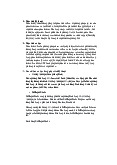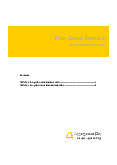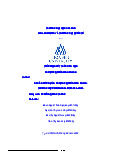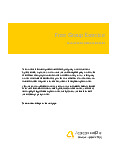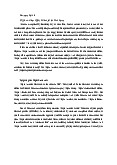

















Preview text:
– – –
“Achieving alignment for corporate brand success: The consumer ”, 1 consumers’ preference (“Nous ne
aux, nous chercherons le plus faux que le faux: l’illusion et
l’apparence”, Baudrillard, 1983
determined by consumers’ overchoice
“cornerstones of contemporary marketing” “essence of a brand” employees’
and to explore the effects of consumers’ authen ’ ’ 2 companies’ senior manag “ ” e company’s selection
company’s quality commitment. Nevertheless, giving a companies’ 3 et al.’s consumers’
most recognized positive outcome of authenticity is its capacity to build consumers’ trust and the company’s action a “ ” ngruency (a “ ” company’s reliability (
only leads to consumers’ trust, but also to consumers’ willingness to pay a premium price 4
credibility, which is “a modus vivendi, a way of living the brand” (Balmer, 2012, p. 28). company’s
In this scenario, corporate brand misalignment have been seen as “breaches of the brand promise”,
emotional branding strategy, as observed by the culture jammin’ Starbucks’ mermaid logo, that was
to test the applicability of Napoli et al.’s (2014) and Bruhn et al.’s
consumer’s perspective in accordance mpanies’ 5 – –
t the brand’s history and values
events in brand’s life, the marketing practices, the pos ’ consumers’ consumers’ perceptions of “strongly disagree” “strongly agree”
Napoli et al.’s (2014) and Bruhn’s (2012) scales consumers’
consumers’ authenticity evaluations are subjective, personally constructed and
consumer’s attitude and beliefs toward an 6 either Napoli et al.’s (
Bruhn et al.’s (2012) or Wiedmann et al.’s “heritage” “ ” “ ” “ ” “ ” – – managers’
’ point of view, the dimension of people and social construction (consumers’ dimension 7 –
(companies’ documents and presentations)
er satisfaction, stakeholders’ consumers’ purchas – s’
’ reliability a Crombach’s alpha analysis has been conducted leading to the – ach’
Brand Authenticity Drivers Quality .933 Heritage .901 Sincerity .793 Originality .867 Reliability .889
Brand Authenticity Outcomes Image .734 Trust .783 Loyalty .800 Premium Price .793
the most “authentic” in the ’ 8
the consumers feel distant from the companies’ vision of “iconic brands” nies’ vision
Napoli et al.’s (2014), Bruhn et al.’s (2012) and Wiedmann et al.’s (2011)
constructs can explain the brands “aura” (Ale
– Mean, variance and Cronbach’s A QUALITY BRANDS Mean Variance Chronbach's alpha Peroni 3.210 .022 .939 Vespa 3.999 .015 .924 Enel 3.285 .050 .914 Cinecittà Studios 2.985 .008 .845 HERITAGE BRANDS Mean Variance Chronbach's alpha Peroni 3.545 .092 .894 Vespa 4.497 .021 .895 Enel 3.479 .016 .881 Cinecittà Studios 3.892 .409 .818 SINCERITY BRANDS Mean Variance Chronbach's alpha Peroni 3.248 .002 .837 Vespa 3.970 .024 .825 Enel 3.121 .002 .757 Cinecittà Studios 3.020 .019 .788 ORIGINALITY BRANDS Mean Variance Chronbach's alpha Peroni 3.140 .013 .875 Vespa 4.355 .012 .901 Enel 3.288 .051 .861 Cinecittà Studios 2.985 .008 .845 RELIABILITY BRANDS Mean Variance Chronbach's alpha Peroni 3.127 .020 .894 9 Vespa 3.777 .009 .871 Enel 3.130 .028 .883 Cinecittà Studios 2.750 .023 .858 s’
press campaign against the new Cinecittà Studios’ owners
peculiar company’s vision and mission. ’t seem to predict t’s coherent
to interpret if compared to the “iconic”
it is clearly shown that the customers’ base “ ” – BRAND IMAGE BRANDS R Square Unstandardized Coefficent p-Value Peroni .677 .090 .000 Vespa .733 .093 .000 Enel .731 .095 .000 Cinecittà Studios .624 .102 .000 BRAND TRUST BRANDS R Square Unstandardized Coefficent p-Value 10 Peroni .754 .094 .000 Vespa .733 .091 .000 Enel .772 .098 .000 Cinecittà Studios .657 .101 .000 BRAND LOYALTY BRANDS R Square Unstandardized Coefficent p-Value Peroni .635 .136 .000 Vespa .247 .061 .000 Enel .698 .139 .000 Cinecittà Studios .580 .100 .000 PREMIUM PRICE BRANDS R Square Unstandardized Coefficent p-Value Peroni .440 .080 .000 Vespa .450 .082 .000 Enel .305 .069 .000 Cinecittà Studios .398 .085 .000
communication, the outcomes of the so called “experience economy” “untrusted brand ” which
We assist to the show of the “consumers’ quest for authenticity” that leads the marketers to the “experience economy”
“corporate brand identity alignment”
of “distinctiveness” a d , finally, of “authenticity” of the brand. 11 – –
“economic agenda” (Beverland, 2006; Beverland et al, 2006, 2008)
“above commerce brands” (Napoli et
“non commercial values” (Beverland, 2005) – –
related to a superior “moral zeitgeist” (Holt, 2004)
companies’ strategies and opera consumers’
(2005) talks about “understated branding and promotion”. 12 customer’s if the Napoli at al.’s (201
’s (2012) scales were mainly based on product – – 13
R., & Campelo, A. (2011), “The four Rs of place branding”,
Alexander, N. (2009), “Brand authentication: creating and maintaining brand auras”,
. J., & Price, L. L. (2000, “Authenticating acts and authoritative performances: Questing for self and community”,
Ballantyne, R., Warren, A., & Nobbs, K. (2006), “The evolution of brand choice”,
Balmer, J. M. (2011), “Corporate heritage –2012)”,
Balmer, J.M.T. (2012a), “Corporate brand management imperatives: custodianship, credibility, and calibration”,
Balmer, J. M. T. (2012b), “Strategic corporate brand alignment: perspectives from i views of corporate brands”,
Balmer, J. M. T., Stuart, H., and Greyser, S. A. (2009), “Aligning identity and strategy: corporate
branding at British Airways in the late 20th century”,
Bertilsson, J., & Cassinger, C. (2011), “Governing consumers
creation branding paradigm”, In
Beverland, M. (2006), “The ‘real thing’: branding authenticity in the luxury wine trade”,
Beverland, M. B. (2005) “Crafting brand authenticity: the case of luxury wines*”, .
Beverland, M. B., Farrelly, F., & Quester, P. G. (2010) “Authentic subcu performances”,
reen, A., & Vink, M. W. (2008), “ ”, 14
Brandt T. (2014) “A vehicle for ‘good Italians’: user design and the Vespa clubs in Italy” in (eds.) “ ”, “ ”, “ ”,
Charmley, R., Garry, T., & Ballantine, P. W. (2013), “The inauthentic other: Social comparison cultures”,
Holbrook M.J. (2001), “The Chain of Effects from Brand Trust and Brand Affect to
Brand Performance: The Role of Brand Loyalty”, –
Cherubini S., Pattuglia S. (2013), “
Approach for Generating Value through “Commutainment”, Proceeedings, International
Chhabra D., Healy D., Sills R. (2003), “Staged authenticity and heritage tourism”,
Deci E., Ryan R. (1991), “A motivational approach to self: Integration in personality” in Dienstbier
(2007), “Theory Building from Cases: Opportunities and Challenges”,
Erdem T. and Swait J. (2004), “Brand Credibility, Brand Consideration, and Choice,” Journal of –
Eggers, F., O’Dwyer, M., Kraus, S., Vallaster, C., & Gü “
d SME growth: A CEO perspective”, “
empirical investigation of iconic and indexical cues in a context of “green” ”, “ ”, “ ”,
Garbarino E. and Johnson M.S. (1999), “The Different Roles of Satisfaction, Trust, and
Commitment in Customer Relationships”, – “ ”, 15 “ ”, “ ”,
Gronroos C. (1994), “From Marketing Mix to Relationship Marketing: Towards a Paradigm Shift in ” in “ ”, “ ”,
Gummesson, E. (1987) ‘The New Marketing –
Term Interactive Relationships’,
Gummesson E. (1998), “Implementation Requires a relationship “ ”, “ ”, “ – ”,
d, N., & Alvarez, J. L. (2005), “ ”,
Kates S.M. (2004), “The dynamics of brand legitimacy: An interpretative study in the gay men’s community”,
Kennick W.E. (1985), “Art and inauthenticity”, Kozinets, R. V. (2001), “
ng the meanings of Star Trek’s culture of ”,
ters, C., & Shelton, J. (2006), “ ”,
J. W., & Koenig, H. F. (2002), “ ”, “ ” 16
Morgan, R.M. and Hunt S.D. (1994), “The Commitment ” –
Morin, J. (2010), “Creating authenticity in an increasingly distrustful world”, J . (2014), “ ”,
wman, G. E., & Dhar, R. (2014), “ ”,
(2000), “The commodification of the American West Marketers’ production of cultural
meanings at the trade show”, , R. A. (2005), “ ”,
e, R. L., & Wood, S. L. (2005), “ ”,
urmann, C., & Riley, N. (2014), “ ”,
., Ilardi B. (1997), “Trait self and true self: cross being”,
J.,and Sabol B. (2002), “Consumer Trust, Value, and Loyalty in Relational Exchanges,” –
leisch, A., & Arsel, Z. (2006), “ ”,
Urban, G.L., Sultan F., and Qualls W.J. (2000), “Placing Trust at the Center of Your Internet Strategy,” –
t, S., & Wuestefeld, T. (2011), “ ”,
t, S., & Wuestefeld, T. (2011), “ ”,
Wild J. (1965), “Authentic existence: A new approach to “Value theory”, in Edie J.M (ed.), “ ”, 17 18
